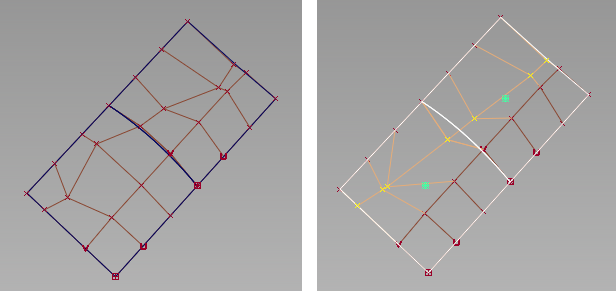Planarizes surface hulls.
Hull Planarize
-
-
– Affects a single CV row.
If this option is selected, holding down the  key lets you select hull lines on several different surfaces and flatten them all onto the same plane.
key lets you select hull lines on several different surfaces and flatten them all onto the same plane.
– Affects all CV rows in U direction (except possibly the first and last).
– Affects all CV rows in V direction (except possibly the first and last).
– Affects all CV rows in both U and V directions (except possibly the first and last).
For the last three settings, the first and last rows of CVs are only planarized if is turned on.
-
-
– The plane is calculated from the view vector (perpendicular to the active window) and the vector joining the end CVs of
the row.
– The plane is chosen as the one that best fits the set of CVs (similar to a least-square fitting) while going through both
end CVs.
-
-
This option appears only when is set to . It controls the number of times the position of the CVs is recalculated in both the U and V direction.
Note
Because the positions of the CVs already planarized in U are affected when planarizing in V, increasing the number of iterations
normally makes those positions converge toward some optimal values.
-
-
If this option is checked, the first and last row of CVs (in U and/or V) are also planarized. The corresponding surface edges
appear as straight lines on the planes of projection.
This option is available when is not set to .
-
-
This option determines the direction of projection for each CV.
– The direction of projection is along the hull line that is closest to the perpendicular of the plane.
– The direction of projection is perpendicular to the plane.
– The direction of projection is along the hull line toward the closest surface boundary.
-
-
If this option is checked, a deviation measurement showing the maximum deviation between the old and new surface appears.
-
-
If this option is checked, a green proxy of the original hull appears after the planarization operation.
 key lets you select hull lines on several different surfaces and flatten them all onto the same plane.
key lets you select hull lines on several different surfaces and flatten them all onto the same plane.

